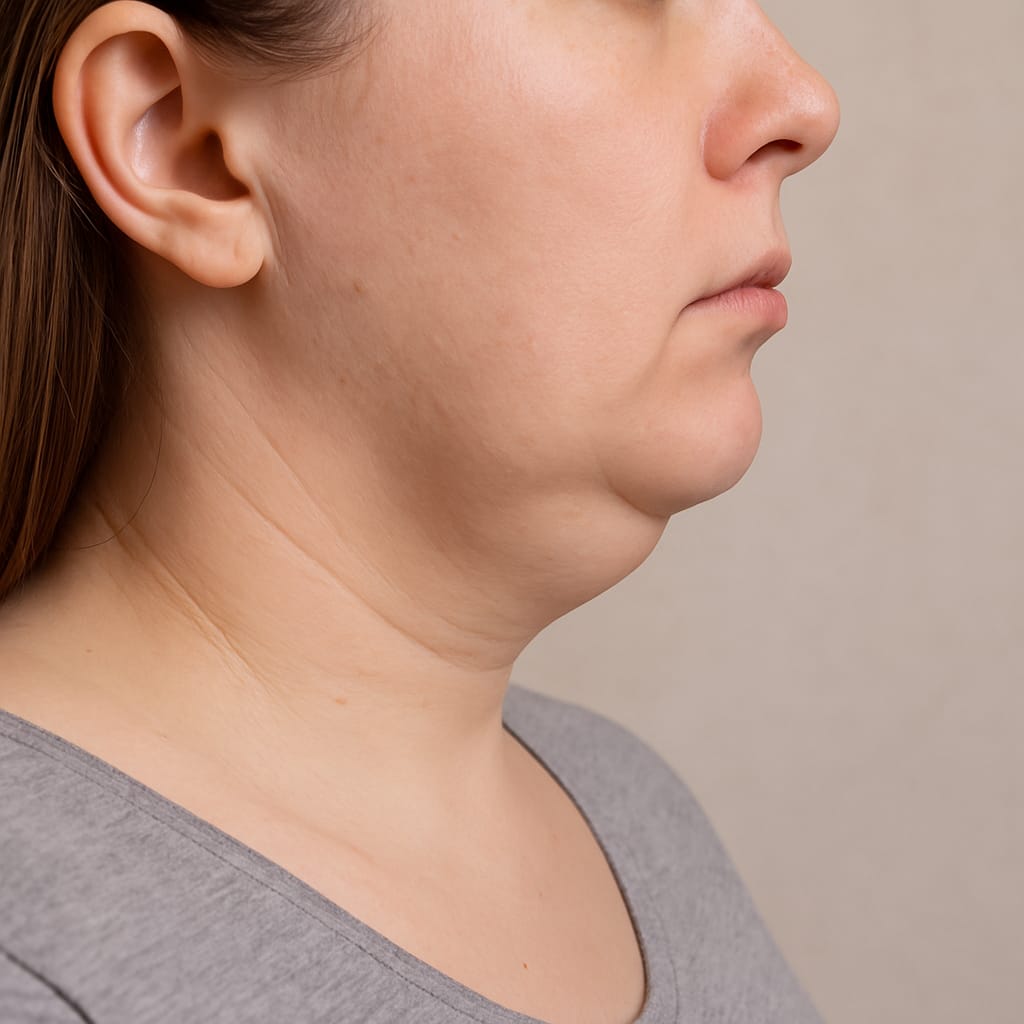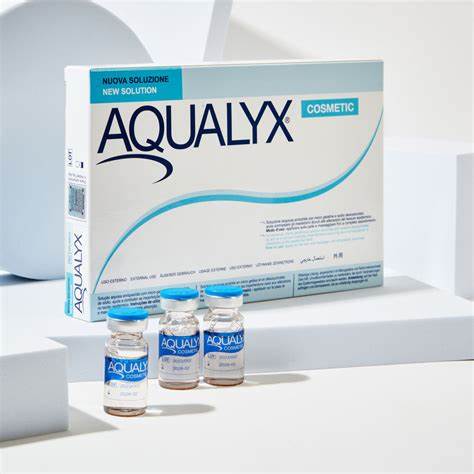Aqualyx is a non-surgical injectable treatment aimed at reducing localised pockets of fat that are resistant to diet and exercise. It belongs to the class of injectable lipolysis treatments. The active component is based on deoxycholic acid (or a derivative thereof), which works by disrupting fat cell membranes, causing the fat cells to break down (lyse). The body’s natural lymphatic and metabolic systems then gradually eliminate the cellular debris.
Importantly, Aqualyx is not a solution for weight loss or large-scale fat removal. It is best suited to small to moderate, well-defined areas of stubborn fat. In the UK and across Europe, Aqualyx holds a CE marking, which indicates it meets certain safety and performance standards within the European Economic Area.
Who Is a Suitable Candidate?
Ideal candidates for Aqualyx share certain characteristics:
- They are already near their ideal body weight but have persistent, localized fat deposits (for example under the chin, on the thighs, upper arms, or flanks).

- They possess good skin elasticity, because Aqualyx reduces fat volume but does not significantly tighten loose or sagging skin.
- They have realistic expectations, understanding that results are gradual and incremental rather than dramatic overnight.
- They are generally healthy, without contraindications such as active skin infections, certain medical conditions, pregnancy, or recent use of medications that might interfere with healing.
The treatment is less appropriate for individuals with diffuse fat over large areas, or those with poor skin tone and laxity.
Common Treatment Areas
Aqualyx can target many of the typical “stubborn fat zones,” especially when the fat is pinchable and localized. Areas commonly treated include:
- Submental region (double chin)

- Upper arms (“bingo wings”)
- Abdomen (lower and upper)
- Flanks / “love handles”
- Inner and outer thighs
- Back and bra-roll areas
- Knees, hips, and outer buttocks
Because the procedure is more effective on discrete fat pockets, broad or diffused fat zones are less suited.
How the Procedure Works
1. Consultation and Assessment
A qualified medical practitioner (doctor or medically trained aesthetic specialist) evaluates your medical history, examines your skin and fat distribution, discusses your goals, and checks for contraindications.
2. Marking & Planning
The clinician marks the areas to be injected and plans the number of injection sites required to cover the region evenly.
3. Numbing
The Aqualyx solution is often combined with a local anesthetic (such as lidocaine) to reduce discomfort.
4. Injection
Using a fine needle or cannula, the practitioner injects the solution into the subcutaneous fat layer at multiple points, distributing it across the target zone.
5. Massage / Manipulation
After injection, the area is typically massaged to help spread the solution evenly and reduce the chance of lumps or nodules. Patients may also be advised to continue gentle massage in the days following treatment.
6. Aftercare Instructions
The practitioner provides guidance on what to do—and what to avoid—after the treatment to support optimal healing and result.
A session for a small area may last 30 to 60 minutes, depending on how many injections are needed and how large the zone is.
Timeline & Treatment Course
Because fat breakdown and clearance are biological processes, results do not appear immediately:
- Some initial improvement may be visible after 3 to 4 weeks.
- Full effects often emerge by 6 to 12 weeks following the final session, as the body processes and removes the dissolved fat.
- Multiple sessions—typically 2 to 4, sometimes more—are commonly recommended, spaced several weeks apart.
- Once fat cells are destroyed, they do not return, so the results are considered permanent if weight remains stable. However, fat in untreated areas can expand with weight gain, so maintaining a healthy lifestyle is vital.
Benefits & Advantages
- Minimally invasive: No incisions, general anaesthesia, or surgical trauma.
- Limited downtime: Many patients resume normal daily activities shortly after treatment.
- Targeted contouring: It’s effective in shaping or reducing small, stubborn fat zones.
- Natural-looking results: Because the fat reduction is gradual, the change tends to appear more natural, with less risk of abrupt contour irregularities.
- Long-term destruction of treated fat cells (provided weight is kept stable).
Risks, Side Effects & Precautions
While Aqualyx is generally safe when performed by experienced and qualified professionals, potential risks and side effects include:
Common / Mild Effects
- Redness, swelling, and tenderness in treated areas
- Bruising at injection sites
- Itching or mild stinging sensations
- Temporary firmness or nodularity under the skin
- Mild discomfort or sensitivity during the first days after treatment
These effects usually resolve within a few days to a week or two.
Less Common / Rare Complications
- Unevenness or contour irregularity if the solution is not evenly distributed
- Persistent lumps or nodules
- Temporary numbness or altered sensation (nerve irritation)
- Allergic reaction to components of the injection
- Infection or abscess if sterility is compromised
- In very rare cases, tissue damage or necrosis if injections are placed too superficially or incorrectly
Because of these risks, it is vital to select a practitioner who is medically trained, properly licensed, and experienced with injectable fat-dissolving procedures.
Aftercare & Recovery
To support optimal healing and results, follow these general aftercare guidelines:
- Avoid exposure to heat (e.g. saunas, hot baths, strong sunlight) for several days
- Perform gentle massage as advised by the clinic
- Avoid strenuous exercise in the first few days, particularly in the treated areas
- Use gentle skincare and avoid aggressive treatments (e.g. harsh exfoliants) in the region for some time
- Maintain good hydration, a balanced diet, and stable weight
- Follow any additional instructions your practitioner gives you (e.g. compression garments, follow-up visits)
Most patients can return to normal daily routines right away, though swelling and tenderness may linger for days.
Cost & Pricing in the UK
The cost of Aqualyx in the UK varies widely depending on:
- The experience and reputation of the clinic / practitioner
- The size and number of areas being treated
- The number of injection points and volume of product used
- Whether multiple sessions are bundled into a package
- Any additional services (consultations, follow-up care, aftercare, photography) included
As a rough guideline, smaller areas may begin in the £250–£350 range or higher in some clinics. Larger zones or multiple sessions will raise the cost. Always ask for a detailed, written breakdown of what is included, the number of expected sessions, and any further costs for follow-up or adjustments.
Here at Radiant, Aqualyx is priced from £200 (smaller areas) – £350 (larger areas).
What to Ask Before You Undergo Aqualyx
Before you commit to the treatment, make sure to ask the clinic/practitioner the following:
- Is the person administering the injections medically qualified (doctor, nurse, or trained aesthetic practitioner)?
- Will you have a full medical consultation, including screening for contraindications?
- What is the protocol for sterility and hygiene?
- Exactly how many injection points are planned, what volume of solution will be used, and how many sessions they anticipate?
- How do they handle complications or uneven results?
- What aftercare is required?
- Are the total costs transparent (consultation, follow-up, potential revisions)?
- Are you a good candidate (any health conditions, medications, skin conditions, pregnancy, etc.)?
- Can they explain the likely timeline, benefits, and realistic expectations—as well as the risks?
Final Thoughts
Aqualyx offers a compelling option for individuals seeking a non-surgical method to reduce stubborn, localized fat deposits. Its minimally invasive nature, relatively short recovery, and natural-looking results make it attractive for those who are close to their ideal weight but struggle with specific trouble zones.
However, success depends heavily on technique, practitioner skill, patient selection, and diligent aftercare. Because of the risk profile—even if relatively low—it is essential to choose a reputable, medically trained provider who offers a transparent assessment and honest expectations.

